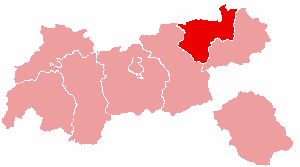Kufstein District facts for kids
Quick facts for kids
Kufstein District
Bezirk Kufstein
|
|
|---|---|
 |
|
| Country | Austria |
| State | Tyrol |
| Number of municipalities | 30 |
| Area | |
| • Total | 969.81 km2 (374.45 sq mi) |
| Population
(2012)
|
|
| • Total | 101,321 |
| • Density | 104.4751/km2 (270.5893/sq mi) |
| Time zone | UTC+01:00 (CET) |
| • Summer (DST) | UTC+02:00 (CEST) |
The Kufstein District is a special area in Tyrol, Austria. It is like a county or region. It shares a border with Bavaria in Germany to the north. To the southeast, it borders the Kitzbühel district. To the southwest, it borders the Schwaz district.
This district covers an area of about 970 square kilometers. In 2012, more than 101,000 people lived here. The main town and administrative center of the Kufstein District is Kufstein.
Contents
Geography of Kufstein District
The Kufstein District is located in a beautiful part of Austria. It includes the lower section of the Tyrolean Inn river valley. This valley stretches all the way to the border with Bavaria.
Valleys and Mountains
Several smaller valleys are also part of the district. These include the Alpbach valley, the Brandenberg valley, Wildschönau, and Thiersee.
The district is surrounded by impressive mountain ranges. These include the Brandenberg Alps, the Kitzbühel Alps, and the Kaisergebirge. These mountains offer great views and opportunities for outdoor activities.
Lakes in the District
The Kufstein District is home to several lovely lakes. The biggest ones are the Reintal lakes, Thiersee, Hechtsee, Hintersteiner See, and Walchsee. These lakes are popular spots for swimming and other water sports.
Towns and Municipalities
The Kufstein District is made up of 30 different communities. These communities are called municipalities. Among them, three are larger towns, and two are known as market towns.
Main Towns
The three largest towns in the district are:
Market Towns
Two communities have the special status of market towns:
Other Municipalities
The remaining 25 communities are smaller municipalities. They are:
- Alpbach
- Angath
- Angerberg
- Bad Häring
- Brandenberg
- Breitenbach am Inn
- Ebbs
- Ellmau
- Erl
- Kirchbichl
- Kramsach
- Langkampfen
- Mariastein
- Münster
- Niederndorf
- Niederndorferberg
- Radfeld
- Reith im Alpbachtal
- Rettenschöss
- Scheffau am Wilden Kaiser
- Schwoich
- Söll
- Thiersee
- Walchsee
- Wildschönau
See also
 In Spanish: Distrito de Kufstein para niños
In Spanish: Distrito de Kufstein para niños

